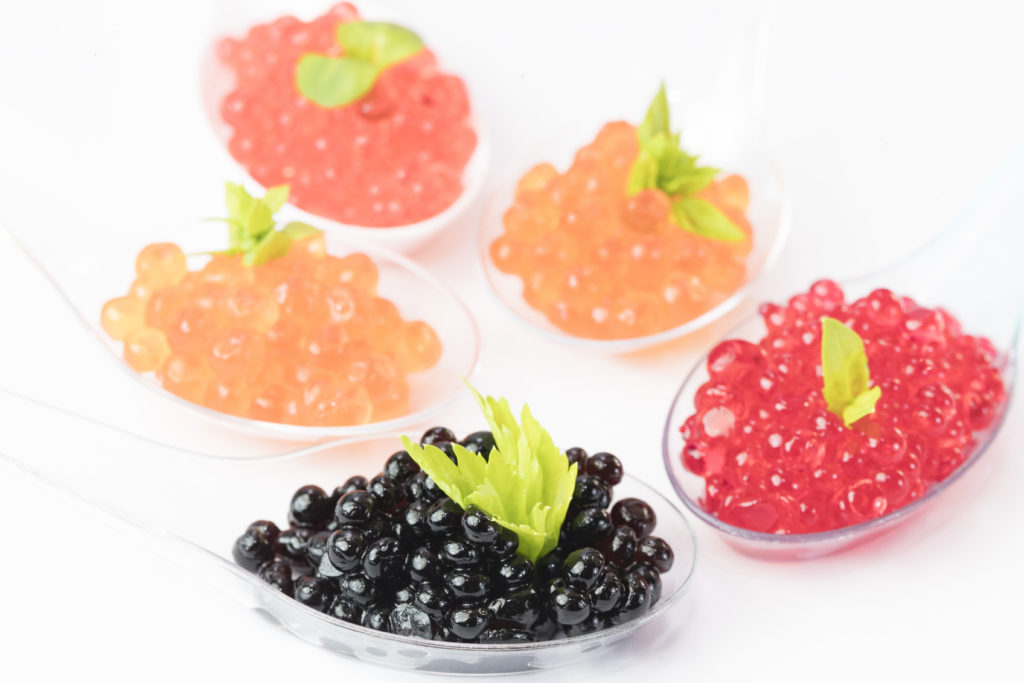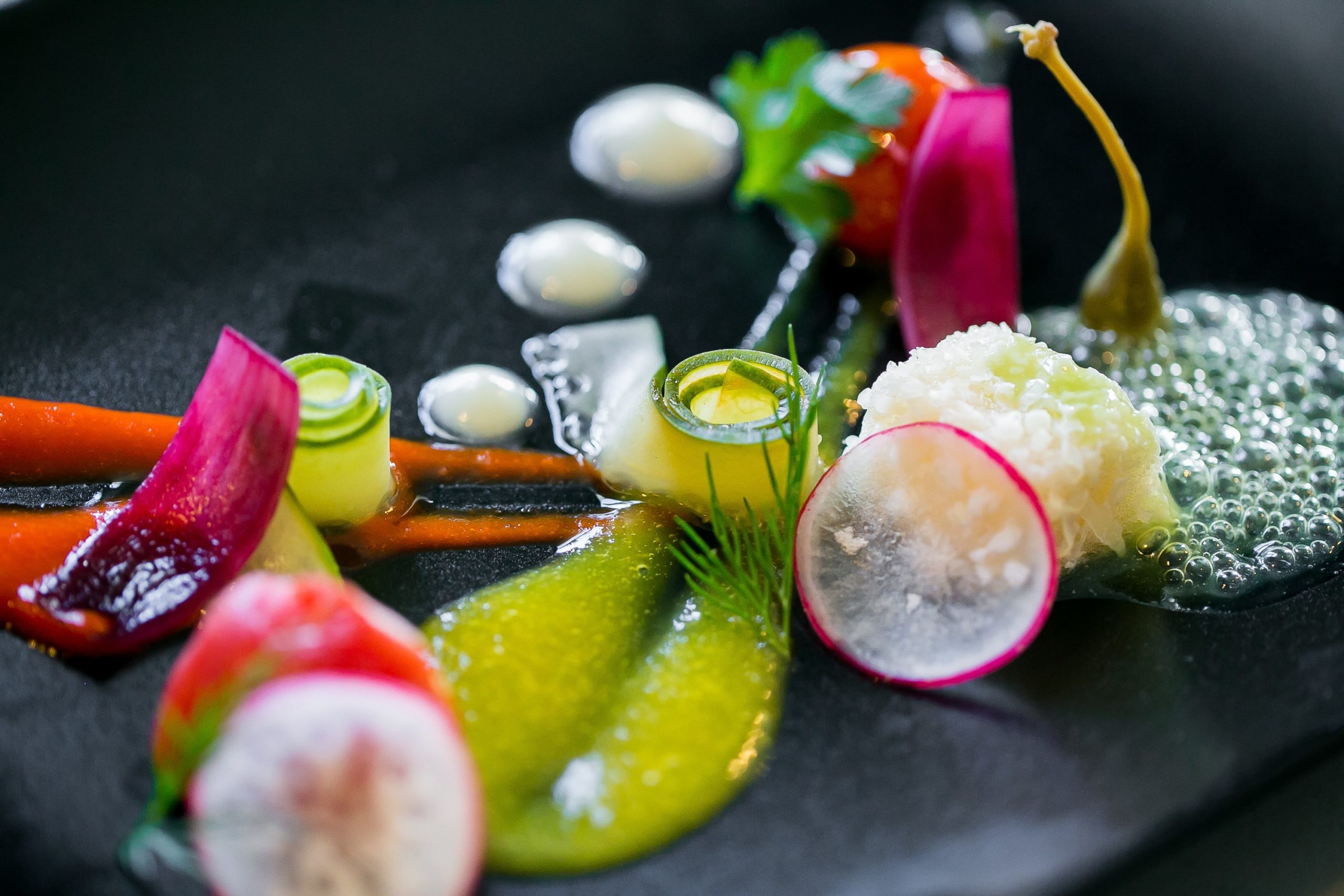One of the most interesting parts of working with food is the marriage between traditional techniques and modern innovation. And nowhere is that more apparent than in the art and science of molecular gastronomy.
By stacking new technology upon a foundation of established food science, chefs and culinarians are able to develop new creations that excite the senses of sight, taste, and smell.
Chefs naturally tend to be creative, and the opportunity to experiment with different ways of making great food is what makes the culinary profession so exciting. That’s why students in Escoffier’s culinary and pastry programs are taught palate development and how to critically evaluate food – which prepares them to be more well-rounded culinarians.
But what exactly is molecular gastronomy? And do you need a science degree or a lab to practice it?
In this primer, you’ll learn about the origins of this innovative culinary style and how you can experiment with it in your own home or restaurant kitchen.
What is Molecular Gastronomy?
When we think of molecular gastronomy, we often imagine edible gasses, liquids turned into uniform spheres, and deconstructed dishes spread across a plate. And those techniques are part of the practice of this food science.
But at its core, molecular gastronomy is simply the science behind how cooking transforms food on a physical and chemical level. For example, the effect of temperature on eggs is something molecular gastronomists would study.
The term was coined in 1988 by Hungarian physicist Nicholas Kurti and French chemist Hervé This.1 But food science was around for many years before that. As far back as the early 1800s, famous chef Marie-Antoine Carême noted that heating the broth for a stock too quickly prevented the liquid from penetrating the meat and resulted in a thinner base.2
“I think it is a sad reflection on our civilization that while we can and do measure the temperature in the atmosphere of Venus, we do not know what goes on inside our souffles.”
Nicholas Kurti
The chemistry of food was further explored through the 1900s, but it was often conducted by large manufacturers with the aim of increasing the shelf-life of prepared foods.
The application of molecular gastronomy science to new cooking methods and innovation began to gain traction after Kurti and This began their International Workshops on Molecular and Physical Gastronomy in 1992. These sessions involved the study of culinary phenomena like aroma release, how different cooking methods change the texture and flavor of raw ingredients, and the impact of mood and presentation on our enjoyment of food.
Molecular Gastronomy in Practice
Starting in the mid-to late 1990s, chefs began using this science to transform food and design new textures and flavors. Several chefs have earned their Michelin stars by the application of these new techniques to their creations.
By separating out flavors and reconstituting them into foods with an unexpected appearance, chefs can delight and excite diners. Restaurants like Chicago’s’ Alinea and England’s The Fat Duck have experimented with dishes from rabbit parfait to nitro-scrambled egg and bacon ice cream.

In reality, the term “molecular gastronomy” is a bit of a misnomer. According to Hervé This, molecular gastronomy is the science. But molecular cooking is what chefs do with it.3 Other chefs prefer the terms avant-garde cuisine, experimental cuisine, deconstructivist cooking, and new cuisine.
But whatever it’s called, molecular gastronomy must have its roots in solid culinary technique and principle. You may be able to extract a food’s essence and put it into a sorbet, but if you don’t understand flavor profiles and dish composition, how will you ensure that it actually tastes good?
Innovation in food science, just like art, requires that you have a solid understanding of the fundamentals. Before delving into more advanced techniques, Escoffier students first cover the theory and chemistry of various ingredients and pastry arts.
“It is critical to have a sound understanding of traditional culinary principles before attempting to push boundaries in cuisine.”
Grant Achatz, Chef/Owner of Alinea, Chicago
A culinary school education could provide the necessary foundation for a future of excitement and innovation in the kitchen.
Molecular Gastronomy Techniques and Ingredients
Molecular gastronomists use a wide variety of new and innovative cooking methods and ingredients. Here are just a few of the techniques used to achieve unexpected shapes, textures, and decoration.
- Flash freezing — liquid nitrogen quickly solidifies the liquid inside fruits and vegetables without creating large ice crystals that would damage the texture
- Sous vide cooking — a thermal immersion circulator cooks food slowly and evenly in a water bath at a stable temperature
- Dehydrated food — turn herbs into dusts for sprinkling or make crunchy sheets of fruits or veggies
- Maltodextrin — this food starch can turn a high-fat liquid into a powder that melts in your mouth, releasing the flavor onto your tongue
- Agar agar — a flavorless seaweed extract used to create gels, mousses, or structural spheres out of liquid
- Foams — can be whipped or expressed out of a whipped cream dispenser to add flavor to a dish without weight
- Deconstruction — breaking dishes down into their component parts, allowing guests to appreciate each piece and create individualized flavor combinations
There is a huge range of culinary techniques that fall under the molecular cooking umbrella. And one of the benefits of culinary school is the opportunity to learn different techniques to make great food. As technology continues to advance, it will be fascinating to see what the next generation invents.
Experimenting with Molecular Gastronomy
You don’t need access to a lab or pricey proprietary equipment to begin exploring molecular gastronomy. Start with a kitchen scale for accuracy and always use the freshest possible ingredients for richer flavors.
Thermal immersion circulators, or sous vide cookers, are available at many big box stores. You can sous vide meat, fish, and veggies, plus more surprising foods like yogurt, custard, cheese curds, eggs, and infused oils.
Agar agar for spherification and maltodextrin for powdering can be found online and at some grocery stores. Whipped cream dispensers are available online or at restaurant supply stores.

Other techniques can be completed with no specialty items at all, like creating sugar glass or deconstructing a dish.
Liquid nitrogen can be dangerous, so we don’t recommend experimenting with it outside of the supervision of an experienced chef.
Building the Foundation
Molecular gastronomy reminds us that cooking is as much science as art. And like any good artist, a chef needs to understand the basics of their craft before they can be truly innovative.
Culinary school graduates are introduced to palate development and sensory awareness, enhancing their ability to critically evaluate different types and styles of food. Even if you prefer your liquids to be wet and your chicken to be solid, learning the science behind these innovative cooking techniques can make you a more well-rounded culinarian.
Start your lifetime of culinary learning with a quality education in Culinary Arts or Pastry Arts at Escoffier.
Did you find this article interesting? You may also like:
- Starting a Career as a Food Stylist
- A Look Back at the Food Trends of the 2010s
- Five Culinary Skills You Can Take With You Wherever You Go
1 https://www.britannica.com/topic/molecular-gastronomy
2 Carême, Marie-Antoine, L’art de la cuisine Française au dix-neuvième siècle, Tome 1, J. Renouard et Cie [etc.], Paris. 1833
3 https://www.britannica.com/topic/Molecular-Gastronomy-The-Science-Behind-the-Cuisine-1707433
This article was originally published on April 29, 2016 and has since been updated.



